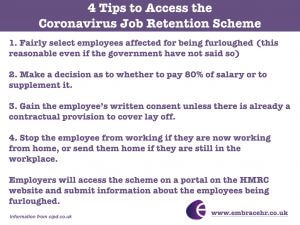Coronavirus (COVID-19) Update
Good evening. We’re sharing our updates for anyone who might visit our website. The scene is changing constantly and we urge you to listen to the broadcasts and update yourself on the gov.uk website, or other official paths such as HSE.
In this Update we will cover some of the FAQ’s that we have been receiving.
What is the difference between sick leave and self-isolation?
In the current situation sickness absence will cover employees:
- Who test positive for the virus
- Who show symptoms of the virus
- Who self-isolate because they have been told to do so by the NHS.
Self-isolation means staying at home and avoiding contact with other people. Employees who self-isolate because of one of the above sickness absence reasons will qualify for SSP. Employees who choose to self-isolate without any of the above, should follow the normal absence procedures and will be entitled to unpaid or annual leave.
Employers have a duty of care to protect all staff and in some cases it may be necessary to suspend an employee on medical grounds, for example pregnant employees, to ensure their safety. Employees who are suspended for this reason will be entitled to full pay.
Self-employed people who have to self-isolate do not qualify for SSP, however, they may be able to claim employment support allowance if they meet the conditions.
Employee’s should check their symptoms using the NHS 111 service, not their GP. https://111.nhs.uk/covid-19/
Employers should continue to carry out Return to Work Interviews with employees after a period of sickness absence to make sure they are fit to return to work and find out if there is any support the employer can provide. Please contact Embrace HR, if you would like more information about this.
Can an employee continue working if they are a carer / support worker and the individual being cared for has symptoms of Coronavirus?
Transmission should be minimised through safe working practices such as wearing personal protective equipment, cleaning and disposing of waste regularly, not shaking dirty clothes. A risk assessment should be carried out to ascertain if the employee’s family may be at risk, for example if they have children or the elderly living with them. Each case should be considered separately.
Can an employee continue working if they are a carer / support worker and the individual being cared for is part of a household that is isolating?
If the individual can remain at a safe distance from the person in the house with symptoms, then care can be provided without additional precautions. One example being are there separate bathroom facilities?
For more guidance on the government website for those working in people’s homes, please click on this link:
Which roles are classified as Key Workers?
The government has specified who Key Workers are. There are many Key Workers, a large majority in the NHS, but also individual carers and support workers are Key Workers such as police, doctors, paramedics, teachers, social workers, case managers, transport workers,
and so many others. For more guidance on Key Workers please access the government website by clicking on this link.
What is the Coronavirus Job Retention scheme?
The Job Retention Scheme involves organisations designating employees as ‘furlough workers’, which is a way to keep employees on payroll without them working, and without them being laid off or made redundant. The government will pay up to 80% of furloughed employee’s wages to a max of £2500 per employee per month.
“Furloughed workers
If your employer cannot cover staff costs due to COVID-19, they may be able to access support to continue paying part of your wage, to avoid redundancies.
If your employer intends to access the Coronavirus Job Retention Scheme, they will discuss with you becoming classified as a furloughed worker. This would mean that you are kept on your employer’s payroll, rather than being laid off.
To qualify for this scheme, you should not undertake work for them while you are furloughed. This will allow your employer to claim a grant of up to 80% of your wage for all employment costs, up to a cap of £2,500 per month.
You will remain employed while furloughed. Your employer could choose to fund the differences between this payment and your salary, but does not have to.
If your salary is reduced as a result of these changes, you may be eligible for support through the welfare system, including Universal Credit.
We intend for the Coronavirus Job Retention Scheme to run for at least 3 months from 1 March 2020, but will extend if necessary.” Excerpt from gov.uk
The scheme is available to all organisations with no restriction on size or type. However, it is only intended to cover organisations who cannot cover staff costs due to COVID 19. It is not known what an organisation will need to show in order to qualify. Employers will need to submit their information to the government via an online portal. More information will follow regarding this.
Organisations will be able to claim for any employee on the PAYE system.
It is likely that contracts which contain the right to lay-off employees on unpaid leave can also be used to designate furlough workers. If contracts do not contain a right to unpaid lay-off, organisations can ask the employee to agree to become a furlough worker.
The finer details of this scheme are not yet known and we shall update further when we know more.
What do I need to consider if my employees are working from home?
The CIPD (2020) have identified the following top ten tips for employers regarding homeworking:
- Review your homeworking policy. Make sure it addresses how employees will be supervised, how the organisation and line managers will communicate with them and how performance and output will be monitored.
- Confirm employee rights.Homeworkers must be treated the same as office-based staff, with equal access to development and promotion opportunities.
- Confirm contact methods and regularity. Advise homeworkers to establish when and how they will have contact with their manager; reporting in at regular times can also help combat isolation and stress.
- Providing equipment.There is no obligation for employers to provide computer or other equipment necessary for working at home, although, given the latest Government advice, employers should do what they can to enable home working.
- IT and Broadband.Employers should confirm in the contractual arrangements if the employee is expected to cover the broadband cost (plus heating and lighting) or if the employer will contribute towards these costs and, if so, to what extent.
- Think about health and safety obligations. Employers are responsible for an employee’s health, safety and welfare, even when working from home.
- Carry out risk assessment.Employers should usually conduct risk assessments of all the work activities carried out by employees those working from home.
- Review working time and length of period.Will employees need to be available for work during strict office hours or work a specified a set number of hours per day?
- Clarify salary, benefits, insurance, tax.Salary and benefits should obviously remain the same during a period of homeworking, although changes to expenses may be appropriate if normal travel expenses and allowances are no longer needed.
- Data protection.Employers should make sure data protection obligations are maintained and employees using their own computer should still process information in compliance with data protection principles.
For more information and guidance on any of the issues mentioned, please contact Embrace HR through our contact form here.
KEEP WELL EVERYONE. KEEP SAFE.
Embrace HR Team
23 March 2020
If you would like to discuss this or any HR subject further please contact our Team at Embrace HR Limited.
If you would like to receive our quarterly newsletter, please sign up here.
Based in Aylesbury, Buckinghamshire, Embrace HR Limited supports SMEs and care packages who do not have their own HR department or those that do but need help from time to time. We also work across the Home Counties of Oxfordshire, Bedfordshire and Hertfordshire, and London.



